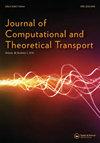On the Effect of Angular and Spatial Discretization on Perturbation Calculations
IF 1.1
4区 工程技术
Q3 MATHEMATICS, APPLIED
Journal of Computational and Theoretical Transport
Pub Date : 2020-10-22
DOI:10.1080/23324309.2020.1834407
引用次数: 0
Abstract
Abstract In this article, different angular flux discretization options, namely discrete ordinates representation and spherical harmonics expansion are compared from the viewpoint of the accuracy of perturbation calculations. The PARTISN discrete ordinates neutron transport solver was coupled with the SEnTRi code, developed at BME, in order to perform perturbation theory calculations in different types of geometry descriptions and angular representations. With the help of the implemented code, the effect of the angular and spatial discretization on the results of perturbation theory calculations was investigated. Exact matches were observed in Cartesian geometries with the direct perturbation method when the discrete ordinates angular representation was used, and small discrepancies were found when the spherical harmonics expansion was applied. In cylindrical geometries, slight differences were observed with both angular expansions, which originate from the nature of the adjoint transport operator in curvilinear coordinate systems. The differences can be reduced to a negligible level with increased expansion order in both cases. Small discrepancies can have a significant effect in sensitivity, uncertainty and transient calculations, which that for high accuracy calculation the discrete ordinates representation of the angular dependent flux should be used or sufficiently high expansion order with the spherical harmonics must be applied.角和空间离散化对微扰计算的影响
从摄动计算精度的角度,比较了不同的角通量离散化方法,即离散坐标表示法和球面谐波展开法。为了在不同类型的几何描述和角度表示中执行微扰理论计算,将PARTISN离散纵坐标中子输运求解器与BME开发的SEnTRi代码相结合。借助实现的程序,研究了角离散化和空间离散化对微扰理论计算结果的影响。采用离散纵坐标角表示时,直接摄动法在笛卡尔几何中观察到精确的匹配,而采用球面谐波展开时,发现了较小的差异。在圆柱形几何中,观察到两种角度展开的细微差异,这源于曲线坐标系中伴随传输算子的性质。在这两种情况下,随着扩展顺序的增加,差异可以减小到可以忽略不计的水平。微小的差异会对灵敏度、不确定性和瞬态计算产生重大影响,因此,为了进行高精度计算,应使用角相关通量的离散坐标表示,或必须使用具有球面谐波的足够高的膨胀阶数。
本文章由计算机程序翻译,如有差异,请以英文原文为准。
求助全文
约1分钟内获得全文
求助全文
来源期刊

Journal of Computational and Theoretical Transport
Mathematics-Mathematical Physics
CiteScore
1.30
自引率
0.00%
发文量
15
期刊介绍:
Emphasizing computational methods and theoretical studies, this unique journal invites articles on neutral-particle transport, kinetic theory, radiative transfer, charged-particle transport, and macroscopic transport phenomena. In addition, the journal encourages articles on uncertainty quantification related to these fields. Offering a range of information and research methodologies unavailable elsewhere, Journal of Computational and Theoretical Transport brings together closely related mathematical concepts and techniques to encourage a productive, interdisciplinary exchange of ideas.
 求助内容:
求助内容: 应助结果提醒方式:
应助结果提醒方式:


